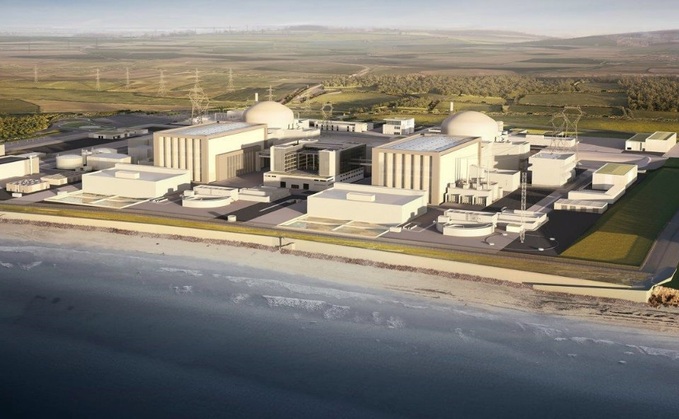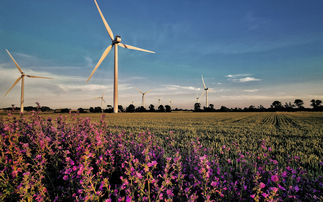
Credit: EDF
The fallout from the latest delays to the flagship Hinkley Point nuclear project are wide-ranging - and they present significant challenges for both the government and the opposition
The more you look at the brief update from EDF confirming the budget and timetable for the Hinkley Point C nuclear budget has slipped yet again, the worse it gets.
The details are bad. A project that was famously expected to be cooking turkeys by Christmas 2017 has seen its start date delayed for the umpteenth time and will now not start generating power until 2029 at the earliest. The turkeys have long since died of natural causes. The costs have also increased still further, from £18bn when the project was approved to the new estimate of £31bn to £34bn in 2015 prices, which means in today's money the bill could spiral north of £40bn.
But it is the implications that flow from this latest delay that are even more worrying. Covid and inflation can take a share of the blame, but EDF's failure to deliver on a timeline and budget that has already been revised multiple times will have a significant knock on impact for the UK's climate, energy security, and even economic strategies. The prospect of a project that was meant to provide seven per cent of the UK's power not coming online until the 2030s presents a series of hugely worrying questions for EDF, for the government, and even for the Labour opposition. Here are just 10 of them.
1. When will Hinkley Point C actually start generating power?
EDF's update sets out three different scenarios for when the project will be completed. A best case scenario would see power exported from 2029, a base case scenario would have the plant online in 2030, and "an unfavourable scenario" could lead to it not coming online until 2031. All scenarios are based on Hinkley Point's Unit 1 coming online, meaning it would take at least another year for the second generation unit to start exporting.
Even the best case scenario is a substantial delay from the previous slated start date of 2027, but there is a big difference between 2029 and 2031, with significantly different implications for the UK's emissions targets.
The latest delays will also inevitably beg the question as to whether the new timeline really is achievable. In a note to staff, Stuart Crooks, the project's managing director, reportedly said work at the site was "well past the halfway mark" and as such "many risks are now behind us". But observers of the project will note that such assurances have been provided multiple times in the past, only for further delays to result. Some of the problems faced by EDF since the last update - high civil engineering costs, recruitment challenges - are not about to be resolved any time soon. The risk of further delays cannot be dismissed.
2. What do the delays mean for Sizewell C and the UK's wider nuclear programme?
Just hours ahead of the update on the delays at Hinkley Point, the government confirmed a further £1.3bn of funding had been released for preliminary work at the Sizewell C site in Suffolk. That move came just a week after the government published a new Nuclear Roadmap, reiterating its commitment to a new fleet of small modular reactors (SMRs) and promising to explore proposals for a third large scale new nuclear power plant project. Both the government and the opposition maintain these projects are a critical component of the UK's decarbonisation plans, alongside the rapid roll out of renewables.
But the idea EDF can take the learnings and expertise from Hinkley Point C and deliver the Sizewell project on time and on budget looks decidedly shaky in the wake of yesterday's delays.
More worrying still, the government and EDF are yet to finalise the additional investors that would allow the project to reach its final investment decision this year. The attempt to attract private investors has already seen the government agree to a Regulated Asset Base (RAB) model for Sizewell C, a controversial approach that effectively sees consumers pay during the construction phase of the project. As former civil servant, Josh Buckland, noted on social media platform X this morning, a model that shifts some of the construction risk onto billpayers looks like "an interesting political prospect".
It is safe to assume prospective investors will demand an even bigger risk premium in the wake of the latest delays to Sizewell's sister project, assuming, that is, EDF and the government can convince them to open their cheque books at all. There will also be concerns about the industry's ability to tackle the skills shortages that have reportedly exacerbated some of the delays at Hinkley Point, which will present a major challenge to plans for a fleet of SMRs. The government's Nuclear Roadmap was already a hugely ambitious undertaking. It looks even more demanding following yesterday's update.
3. What does the delay mean for the UK's carbon targets?
The sheer scale of the Hinkley Point C and Sizewell C projects - each plant is slated to provide around seven per cent of the UK's power - means any delay will have a tangible impact on the UK's economy-wide emissions targets.
Most urgently, the UK's international emissions target submitted under the Paris Agreement requires a 68 per cent cut in emissions against 1990 levels by 2030, which is broadly in line with the domestic target of a 57 per cent cut in emissions for the Fifth Carbon Budget period running from 2028 to 2032. And then there is the Sixth Carbon Budget that runs from 2033 to 2037 and requires a 78 per cent cut in emissions by 2035. The Climate Change Committee (CCC) has already expressed concern the UK is off track to meet its medium-term emissions goals and the government is facing legal action alleging its decarbonisation plans are inadequate. These concerns will only become more acute if the anticipated emissions savings from new nuclear projects have to be deferred.
According to a snap analysis from Carbon Brief's Simon Evans, Hinkley Point was set to provide 10 million tonnes of annual CO2 savings by displacing gas power generation, which would be equivalent to around four per cent of the savings required to meet the UK's 2030 target. If the project does not come online until after 2030 it leaves the government having to find substantial emissions reductions from elsewhere. If Hinkley Point is delayed further or there is a knock-on impact on the timeline for Sizewell C, then the Carbon Budgets for 2030s could face a similar shortfall in projected emissions reductions.
4. Will Rishi Sunak be forced into a rethink over his decarbonisation plans?
When challenged over his controversial decision last autumn to roll back a number of key decarbonisation policies, Prime Minister Rishi Sunak tetchily insisted the UK was still on track to meet all its emissions targets.
This assertion was already highly contestable. The CCC said the decision to dilute energy efficiency standards for rented properties and defer the date for banning new petrol and diesel cars would make it harder to meet current targets. The government has rejected calls from the CCC and others for it to make public its modelling showing how emissions targets will be met.
But the government's modelling would have been based on the assumption Hinkley Point C would come online in 2027 as planned. It remains to be seen if the government can still credibly claim the 2030 target will be met in the event Hinkley Point is not online by the end of the decade. But it looks as if a sizeable gap in the government's decarbonisation plans for the 2020s has just opened up that will need plugging somehow, regardless of Sunak's visible antipathy towards more ambitious decarbonisation policies. Meanwhile, a court hearing on Ministers' decarbonisation plans is imminent.
In a statement, the Department for Energy Security and Net Zero (DESNZ) said that Hinkley Point C "is not a government project", and as such "any additional costs or schedule overruns are the responsibility of EDF and its partners and will in no way fall on taxpayers".
"We've ended the stop-start approach to nuclear and recently launched a roadmap setting out the biggest expansion of nuclear in 70 years, simplifying regulation and shortening the process for building new power stations - meaning cleaner, cheaper and more secure energy in the long-term," it said.
"We're also investing millions in new technologies and launched Great British Nuclear's Small Modular Reactor competition, which aims to be the fastest of its kind in the world."
5. Where does this leave Labour's clean power plans?
Labour's goal of delivering a clean power system by 2030, a full five year's earlier than the government's target date, was already a hugely ambitious stretch target.
Many analysts acknowledge it should be possible to drastically accelerate the UK's clean energy development through a combination of planning reform and increased investment. But there is widespread scepticism the necessary grid upgrades, energy storage systems, and carbon capture capacity can be deployed in time to meet Labour's 2030 goal.
For there to be any chance of meeting the target everything would have to go right, and now something has already gone wrong. Will Labour stand by a target that assumed Hinkley Point C would be providing seven per cent of the UK's power well ahead of 2030, or will it defer the goal and blame the current government's inability to deliver a single nuclear power plant after 13 years in power?
More broadly, how might a Labour manifesto respond to the challenges the government is now facing and deliver a new generation of nuclear projects without it succumbing to yet more delays and cost blowouts?
6. How much will the delays cost EDF?
EDF's bottom line has already taken a substantial hit from the repeated cost overruns, but there are further financial impacts for the French energy giant to consider.
Under the terms of the contract for difference (CfD) that provides EDF with a guaranteed price for the power it sells from Hinkley Point the project has a commissioning window of 2025 to 2029. If the plant is not online by 2029 every day that passes eats into the 35-year contract under which EDF enjoys guaranteed prices for its power. And then there are the implications for the on-going negotiations over financing for Sizewell C.
As critics have repeatedly pointed out, the CfD EDF negotiated with the government remains generous, but continued delays and cost increases have dealt both financial and reputational blows.
7. Can current reactors have their life extended further?
One of the main rationales for new nuclear projects in the UK is they are needed to replace the current fleet of reactors that is due to retire over the coming decade. The fear was that without new reactors, retiring plants would end up being replaced by increased gas generation, making it harder for renewables to deliver full grid decarbonisation. The repeated slipping of the timetable for bringing new reactors online makes that high emission scenario more likely.
The nuclear industry has responded by announcing plans to extend the life of existing reactors, with EDF confirming earlier this month it is to invest £1.3bn to defer the retirement deadline for at least two of its reactors, subject to regulatory approval. But even if it gets that approval the Heysham 1 and Hartlepool reactors are still slated to close in March 2026, while the Heysham 2 and Torness power stations are currently scheduled to come offline in March 2028. That would see four reactors powering down before Hinkley Point comes online.
EDF has said it plans to review the current projected lifetimes again by the end of 2024 and it hopes to be able to continue generating beyond these current forecasts. The pressure on the company to do so will be acute.
8. Where is the Energy Security Summit?
With impeccable timing, Politico yesterday ran a story under the headline 'The UK's great disappearing energy summit'.
The report claims plans announced last summer by then UK Energy Security and Net Zero Secretary Grant Shapps for a London Energy Security Summit to mark the second anniversary of Russia's invasion of Ukraine are still not finalised. Key diplomats and industry insiders have not received invitations and it is unclear if the conference will proceed.
The Department for Energy Security and Net Zero insists plans are advancing and more details will be announced in due course, but critics allege the failure to promote the Summit is just further evidence of the government's slapdash approach to energy security.
In the wake of Russia's invasion of Ukraine and the resulting surge in energy costs, the government refused to relax planning restrictions for onshore wind farms, provided only a modest increase in energy efficiency funding, and initially declined to launch an energy-saving campaign. Instead, Ministers made great play of their plans for new offshore wind and nuclear projects. And now the flagship nuclear project has been delayed yet again, meaning the UK will be reliant on higher than anticipated levels of gas imports for longer than expected.
Some Ministers will no doubt argue the delays underscore the need for more domestic oil and gas drilling, but given such projects are also unlikely to deliver until the 2030s or later calls will continue to grow for a revamped energy security strategy that is less dependent on high-risk mega projects.
9. Is there a plan B?
All of which leads to the big question being asked by green groups this morning: is there a plan B?
Anti-nuclear campaigners have long argued new nuclear projects are too expensive and take too long, and as such policymakers should be more focused on the renewables and energy efficiency projects that can cut emissions in the near term. Every update from EDF confirming fresh project delays and cost overruns seems to make their argument more compelling.
But both the government and the opposition maintain nuclear has a critical role to play in a decarbonised grid, complementing intermittent renewables in a way that ultimately delivers a more reliable and affordable clean power grid. It is an argument that makes sense, but the problem is that to deliver on that vision new nuclear projects actually have to get built.
The latest setback at Hinkley Point begs two critical questions. Firstly, what reforms can policymakers push through to ensure new projects are delivered faster and at a more competitive cost. As campaign group Britain Remade pointed out today, other countries are able to deliver new nuclear projects on time and at lower cost. Why not the UK?
And secondly, if Hinkley Point is delayed further, if investors cannot be found for Sizewell C, what does the government intend to do to close the resulting emissions gap? Will there be more investment in energy efficiency, offshore wind, and grid upgrades? If not, why not?
10. How will faltering decarbonisation plans play into a fractious election campaign?
At Prime Ministers Questions this afternoon an underfire Rishi Sunak repeatedly attacked Labour leader Keir Starmer over the opposition's £28bn green investment plan, insisting it would lead to tax increases.
This is not necessarily true. Labour counters the target can be delivered through a combination of existing government spending plans, economic recovery, and borrowing that would be subject to its strict fiscal rules. But the repeated Conservative attacks have already been sufficient to make Labour dilute the plan and some sources remain convinced Starmer could yet ditch it altogether.
Green issues look set to play a central role in what is going to be an extremely fractious election campaign, but to date the focus has been on questions around the affordability of green investment plans rather than what the main parties intend to do to catalyse green growth and deliver on climate targets they are both signed up to.
How does Rishi Sunak's self-styled ‘pragmatic' approach to decarbonisation work if he can't deliver promised nuclear projects on time? If Labour is going to invest £28bn a year in green infrastructure could some of it be used to help ensure Sizewell C is actually delivered? If the Conservatives aren't willing to borrow to invest, favouring tax cuts and further spending cuts for public services instead, how do they envisage the emissions gap created by the Hinkley Point delays being bridged? What does Labour intend to do differently to avoid the delays that have afflicted the nuclear industry over the past decade?
The latest delays to Hinkley Point presents a lot of important questions. The hope is that they can be answered well ahead of what promises to be a critical election for the UK's decarbonisation strategy. But judging by the deeply unserious pre-election maneuvering to date, I would not hold your breath.









